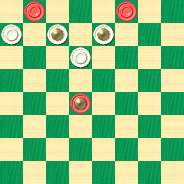The Checker Maven
Jump to navigationQuigley's Rule

Astrologer Joan Quigley had her moments of fame as astrologer to nothing less than the White House during the years of the Reagan presidency in the United States. President Reagan's wife, Nancy, made the acquaintance of Ms. Quigley on a television show, and apparently was quite impressed. Ms. Quigley claimed, at least indirectly, in some respects to "rule" the White House by advising the President on key matters and protecting him from the "curse" that supposedly befell U.S. presidents elected in years whose number was evenly divisible by twenty.
We certainly can't comment in any authoritative manner on Ms. Quigley's claims, though we do recommend a certain amount of scientific skepticism. But one thing we can comment upon is the game of checkers, and in today's episode from our Checker School series, we present a position credited to G. Rule and P. Quigley, which we've chosen to call "Quigley's Rule"; perhaps not quite the same as "Quigley Rules," but we will have to make do.
BLACK

WHITE
White to Play and Win
W:W5,K6,K7,10:B1,3,K18.
We would definitely call this a "stellar" problem. White has an extra man but it's stuck in the double corner, and Black has what seems like a strong bridge position. This type of position will surely come up again and again in your own games, so align your stars and work it through. When you've predicted the right moves, click on Read More to see the solution, sample games, and explanatory notes, taken as usual from Ben Boland's Famous Positions in the Game of Checkers.![]()
Solution
Lettered notes are from Mr. Boland's book. Numbered notes are from computer analysis with Ed Gilbert's KingsRow and 10-piece endgame database.
7-11, 18-14---1, 11-8, 14-7---2, 6-2, 3-12, 2-11, 1-6, 5-1, 6-10, 1-6, 10-14, 6-10, 14-18, 10-15, 18-23, 11-16---3. White Wins.
Game: 11-15, 23-19, 9-14, 22-17, 5-9, 17-13, 14-18, 19-16, 12-19, 26-23, 19-26, 30-5, 8-11, 27-23, 4-8, 32-27, 15-19, 23-16, 11-20, 24-19, 8-11, 25-22, 10-14, 29-25, 7-10, 22-17, 2-7, 25-22, 11-15, 27-23, 15-24, 28-19, 10-15, 19-10, 6-15, 17-10, 7-14, 22-17, 15-18, 17-10, 18-27, 31-24, 20-27, 13-9, 27-31, 9-6, 31-26, 6-2, 26-22, 2-7, 22-18, 21-17, 18-14, 17-13, 14-18, 13-9, 18-15, 9-6, 15-18, 6-2---A, 18-15, 2-6, 15-18. Forms above position. Stroud vs. Sullivan, Game No. 32, American Checker Review, Vol. 2, 1889.
Game: 10-15, 22-18, 15-22, 25-18, 11-15, 18-11, 8-15, 21-17, 4-8, 17-13, 9-14, 29-25, 6-10, 24-20, 2-6---C, 28-24, 8-11---B, 23-19, 5-9, 26-23---D, 15-18, 30-26, 14-17---E, 23-5, 17-22, 25-18, 10-15, 19-10, 7-30, 31-26, 30-23, 27-18, 12-16, 32-28, 6-10, 18-15, 11-18, 20-11, 18-23, 24-19, 23-26, 11-7, 26-30, 7-2, 10-14, 19-15, 30-25, 15-10, 14-17, 2-6, 17-22, 6-9, 22-26, 9-14, 25-22, 14-17, 26-31, 17-26, 31-22, 13-9, 22-17, 9-6, 17-13, 6-2, 13-9, 28-24, 9-13, 2-6, 13-17, 24-19*, 17-22, 19-16, 22-18, 16-11, 18-15, 11-7, 15-11, 7-2, 11-15, 2-7, 15-18. Forms above position. F. Tescheleit, "Master Play," Part 4.
A---7-11 saves a few moves.
B---15-19 black may draw---4. Tescheleit.
C---A favorite move of the late C. F. Barker. He played it with varied success until the appearance of Richmond's play.
D---Solution to No. 283 Draughts Review, by Richmond and corrects No. 58 in the Scottish Draughts Quarterly.
E---1-5 is shown to lose by 32-28, 3-8, 19-16, 12-19, 23-16, etc. White Wins.
1---If 18-22 then 6-9 22-18 11-16 18-23 10-6! 1x10 16-11 23-18 9-6 10-15 5-1 and Black loses a man and the game no matter what he plays, for instance 15-19 11-7 3x10 6x24 White Wins.
2---If 3-12 then 6-2 14x7 2x11 1-6 5-1 6-9 1-6 9-14 6-10 14-18 10-15 and now 18-22 loses on the move and 18-23 loses at once to 11-16 12-19 15-24 White Wins.
3---12-19 15-24 and White wins on the move.
4---Computer analysis here gives 14-17 to draw. With the suggested 15-19, after 24-15 10-19 23-16 12-19 the game is also a probable draw though it takes deep computer analysis to come to this evaluation.
The above position, colors reversed, may be found as position No. 104, "The Draught Board," April 1, 1870. It was an end game between George and David Rule. King on 18 is on 17, but the play is the same. It may be found in Lyman's Problem Book, and it is No. 1005 (with 18 on 17), in Gould's Problem Book. But as the position stands it may be found as No. 796 and No. 1010, credited to P. Quigley in Gould's Problem Book, 1884.
With a Black man on 20 and a White man on 28, the position is No. 12 by F. Dunne, from Switcher Game, the Draughts Players' Weekly Magazine, Feb. 7, 1885; 7-11, 18-14, 10-7, 1-10, 5-1, 14-17, 1-5, 10-14, 5-9, 3-10, 9-18, 17-13, 18-22, 10-14, 11-7, 14-17, 22-18, 13-9, 7-10, 17-21, 18-22. White wins by Second Position.
You can email the Webmaster with comments on this article.
